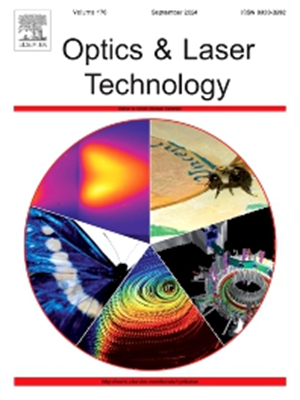15.72 w自调q Tm:YAP平板激光器
IF 5
2区 物理与天体物理
Q1 OPTICS
引用次数: 0
摘要
利用基态吸收效应,实现了高平均输出功率(Pout)自调q (SQS)掺铥的YAlO3 (Tm:YAP)板状激光器。利用端泵送板状晶体的理论模型预测了Tm:YAP中的温度和应力分布。利用三种曲率的输入反射镜获得了稳定的SQS脉冲序列。在曲率为500 mm的条件下,泵浦入射功率为66.80 W,输出功率为15.72 W,脉冲宽度为1.08 μs,斜率转换为57.1%。此外,SQS激光器的Pout是稳定的,在1小时内获得了0.45%的均方根稳定性。该激光器具有良好的光束质量因子M2 <;1.3. 据我们所知,在2 μm波段,与其他SQS激光器相比,该激光器具有最高的Pout、斜率效率和光束质量。本文章由计算机程序翻译,如有差异,请以英文原文为准。
A 15.72-W self-Q-switched Tm:YAP slab laser
A high average output power (Pout) self-Q-switched (SQS) Tm-doped YAlO3 (Tm:YAP) slab laser was achieved using the ground-state resorption effect. A theoretical model of the end-pumped slab crystal was used to predict the temperature and stress distributions in Tm:YAP. Stable SQS pulse trains were obtained using input mirrors of the three curvatures. Under a curvature of 500 mm, a Pout of 15.72 W and a pulse width of 1.08 μs were obtained with an incident pump power of 66.80 W, corresponding to a slope conversion of 57.1 %. In addition, the Pout of the SQS laser was stable, and a root mean square stability of 0.45 % was acquired in an hour. The laser exhibited a good beam quality factor M2 < 1.3. According to our knowledge, this laser has the highest Pout, slope efficiency and beam quality compared with other SQS lasers in the 2 μm band.
求助全文
通过发布文献求助,成功后即可免费获取论文全文。
去求助
来源期刊
CiteScore
8.50
自引率
10.00%
发文量
1060
审稿时长
3.4 months
期刊介绍:
Optics & Laser Technology aims to provide a vehicle for the publication of a broad range of high quality research and review papers in those fields of scientific and engineering research appertaining to the development and application of the technology of optics and lasers. Papers describing original work in these areas are submitted to rigorous refereeing prior to acceptance for publication.
The scope of Optics & Laser Technology encompasses, but is not restricted to, the following areas:
•development in all types of lasers
•developments in optoelectronic devices and photonics
•developments in new photonics and optical concepts
•developments in conventional optics, optical instruments and components
•techniques of optical metrology, including interferometry and optical fibre sensors
•LIDAR and other non-contact optical measurement techniques, including optical methods in heat and fluid flow
•applications of lasers to materials processing, optical NDT display (including holography) and optical communication
•research and development in the field of laser safety including studies of hazards resulting from the applications of lasers (laser safety, hazards of laser fume)
•developments in optical computing and optical information processing
•developments in new optical materials
•developments in new optical characterization methods and techniques
•developments in quantum optics
•developments in light assisted micro and nanofabrication methods and techniques
•developments in nanophotonics and biophotonics
•developments in imaging processing and systems

 求助内容:
求助内容: 应助结果提醒方式:
应助结果提醒方式:


